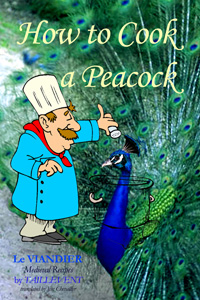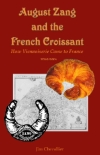CHEZ JIM
BOOKS |
A History of Wine in France
Eighteenth Century |

|
The Greeks; but the Gauls liked it and were quick learners.
The Romans, who taught the Gauls to do the same. They sometimes added pitch to it too.
They did, and for a very long time the resulting wine was considered excellent. (A few still grow there today, but don't ask about the wine...) |
From "An Overview of Le Grand d'Aussy on Wine":
"Le Grand d'Aussy's chapters on wine appear at the end of the first volume and the start of the second volume in his first edition, after a section on beer and cider and before those on brandies, spirits and hot and cold drinks. Since modern readers may be more or less interested in the different aspects of the subject he chooses to address, this overview is provided as a guide to what lies ahead.
He begins with a look at the origins of wine in France – a subject on which ancient authorities differ – and the trade in it between the Gauls and the Romans. Though wine was adopted early in France, vineyards initially did not appear far above the Cevennes. Some of the best grapes were already found in Bordeaux, though other regions (not always definitively identified) were mentioned.
After discussing Gallic methods of grape cultivation, he discusses the qualities of some of their wines and the use of pitch (among other substances) to flavor – arguably adulterate – wine. After touching on some of the other means of improving wines (including the use of sugar in his own period), he describes the use of smoke by both the Gauls and the Romans to thicken and “age” wine, and provides a detailed look at of one way of doing this..."
|
Some samples from the book"It is not that we do not find among the Ancients abundant matter to furnish an answer; but the testimonies of these are, as I have already had occasion to note several times in similar cases, so opposed and so contradictory that they multiply the difficulties, rather than resolving them. Open
Justin and Strabo: you will see there that it was the Phoceans who
first brought the vine to Gaul, and the first to teach the Gauls the
art of cutting and cultivating it. Consult Pliny and he will tell you
to the contrary that the first to make wine known to the Gauls was a
Helvetian, named Elicon, who, after having made some money in Rome,
wanting to return home, took with him some wine and some dried fruit
which in passing through Gaul he sold to the inhabitants, urging them
to conquer the happy land which produced so sweet a liquor. Will you
trust Plutarch and Titus-Livy? It was not a Helvetian, but to a
Tuscan that was due the Gauls' expedition..." In
the XVth century, these boutiaux
or boutilles
took the name of bottles; and this name was kept afterwards for the
glass flasks which we use today, when these became customary."
|
Table of Contents
|
About Le Grand's Work"The current volume has been extracted, translated and retitled from Pierre Jean-Baptiste Le Grand d'Aussy's classic work on French food and drink, which has come down to us with the slightly misleading title of Histoire de la vie privée des Français depuis l’origine de la nation jusqu’à nos jours; that is, “History of the private life of the French from the origin of the nation until our days”. Though Le Grand originally intended to produce such a comprehensive work, in practice he only finished the three volumes on food and drink (first published in 1783). Incomplete as these may be in terms of the overall project, they are almost manically thorough in their examination of the specific subject and have remained, over the centuries, some of the prime sources on the subject. Not only do even modern writers continue to draw on them for key information, more than one writer (in both French and English) has shamelessly copied whole stretches of Le Grand's work, well after it was written, and presented it as their own. ...He is, in a word, not only an informative but a lively and enjoyable writer, but one who, in English, is more often cited than translated at length. The present effort is intended to remedy that, if only in small measure." A glimpse at Le Grand's historical list of wines"A piece from this time has come down to us (Fabliau de la Bataille des vins) from even a few years before the account, and already, like him, cited above, which gives us the list of those of France said to be the best, and which leaves us nothing to desire on this point. Among the wines of Province or of regions, the Poet praises those of the Gâtinais, of Auxois, of Anjou, and of Provence. Regarding particular wines, known in different Provinces, one sees that, The Angoumois, had that of Angoulême. The Aunis, that of La Rochelle. Auvergne, that of St. Pourçain (a).
The Berry, of Santerre, of Châteauroux, of Issoudun, and of Buzançais. Champagne, of Chabli [near, and at one time part of, Champagne], Epernay, Rheims, Hauvilliers, Sezanne, Tonnerre. Guyenne, of Bordeaux, Saint-Emilion, Trie and Moissac. The Isle de France, of Argenteuil, Deuil, Marly, Meulan, Soissons, Montmorenci, Pierrefite and St. Yon. The Languedoc, of Narbone, Béziers, Montpeller, and Carcassonne. The Nievernais, that of Névers, Vézelay...." |
All text and translations copyright 2011 Jim Chevallier.
Please do not reproduce or post elsewhere without prior permission.
Interested in the history of food and drink? Here are four other books from Chez Jim:
|
Yes,
the French kings really did eat peacocks - and swans, and herons, and
blackbirds too. Taillevent, the cook who served two of them, not only cooked
these dishes, but left a book on how to do it. He called it Le Viandier.
In this new translation, it's called: How To
Cook A Peacock ·
For recreational
medievalists ·
For lovers of
culinary history ·
For students of
medieval life ·
For adventurous cooks
|
Have you ever wanted to make an eighteenth century meal? This book, starting with a menu from a classic French cookbook, tells you how. Even if you don't have a house full of servants and a kitchen with numerous hearths, you'll find enough original French eighteenth century recipes - newly translated - here to entertain a number of guests in true eighteenth century style. This collection includes recipes for game, veal, beef, chicken and various sauces, salads and other tasty items, worth making on their own or as part of a full, elegant period meal. |
The second volume in this series presents VEGETARIAN recipes from Old Regime France. No, it's not a modern gimmick - in Catholic France, meat was forbidden on some days, and so one of the choices was this "meal of roots"; including not only carrots, parsnips, beets, turnips, etc., but also lentils and peas, onions, artichokes and asparagus. This collection includes over 100 recipes for soups, stews, salads, sweets, even... mock fish, made from vegetables of every sort (and even a fish or two). |
The story of how the croissant actually came to France is far more interesting than myths about Marie-Antoinette and a siege of Vienna. The story of how viennoiserie came to France is also that of an Austrian entrepreneur who changed French baking forever before going back to Vienna and doing the same for the Austrian press.
|
UPDATED: August 27, 2022




